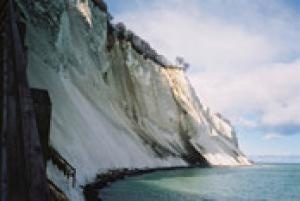May 11 2009
It is a mystery to many people why the world is running out of oil when most of the world's oilfields have only been half emptied. However some of the oil that has been located is trapped as droplets of oil in small cavities in the surrounding rock or is stuck to the walls of the underground cavity and cannot be accessed by the techniques currently used in the oil industry.
 Chalk cliffs in Denmark. (Credit: Møns Klint)
Chalk cliffs in Denmark. (Credit: Møns Klint)
Now, new research may have come up with an explanation as to where and how North Sea oil clings to underground rocks. This explanation could turn out to be the first step on the way to developing improved oil production techniques with the intent of increasing oil production from Danish oil fields.
A research group at the Nano-Science Center, part of the Institute of Chemistry at University of Copenhagen has investigated drill cores collected from North Sea oil fields using an atomic force microscope. Their investigations show that the spaces which contain oil have totally different surface qualities than expected from our knowledge of the minerals which make up the rock. The rocks which contain oil in the Danish part of the North Sea are primarily chalk – the same type of rock that the cliffs of Stevns and Møns are made of. Assistant Professor Tue Hassenkam lead the research, whose preliminary results were published in the respected scientific publication PNAS (Proceedings of the National Academy of Sciences) this week. He says that this is the first time that investigations of this type have been carried out on chalk from an oil field in the North Sea.
'Previous investigations were carried out on the surface properties of pure mineral crystals. But our investigation has shown that this chalk has a different and more complex structure' says Tue Hassenkam.
The oil bearing layers in the subsurface are reminiscent of a sponge. The oil "hides" in tiny pores and gaps and only some of the oil can be pressed out of the chalk and into the borehole by injecting water into the chalk layer. The rest is left behind as small droplets of oil surrounded by water either in small gaps in the rock or stuck to the walls of the pores. The chalk particles ought to repel oil if they act like particles of the mineral calcite, which chalk is almost 100% made up of. However the new investigations, carried out with a particularly powerful microscope, have shown that the surfaces of the pores in the chalk are partially covered in a material which oil can stick to. Ass. Prof. Hassenkam believes that the surprising behaviour of the material in the surface of the chalk can be explained by studying how the chalk was formed.
'Chalk is actually the casings of ancient algae. The algae gave their cases a type of "surface coating" to make them resistant to water. And it is probably this surface coating that we can see in action here, even 60 million years later' according to Ass. Prof. Hassenkam.
If we can manage to squeeze even a few percent more oil out of the seabed under the North Sea it could be worth millions of Danish crowns (DKK) for Denmark. Therefore Mærsk Oil and Gas AS on behalf of DUC (Dansk Undergrunds Consortium) along with Danish National Advanced Technology Foundation are supporting a project being carried out by Professor Susan Stipps' research group – the so-called Nano-Chalk Venture, which has been ongoing for the last two years. Tue Hassenkam originally became interested in chalk because he found the algae casings so beautiful. Today, after a year's work in front of a microscope, he is glad that his work also has a practical application. An understanding of how the oil clings to the chalk can possibly help develop a method to release it. And that will be the second part of the Nano-Chalk Venture.